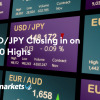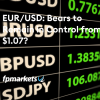EUR/USD:
Monthly timeframe:
(Technical change on this timeframe is often limited though serves as guidance to potential longer-term moves)
The euro nudged to a third successive monthly gain against the US dollar in July, adding nearly 5 percent. The move toppled long-term trendline resistance (1.6038) and made contact with the upper border of supply from 1.1857/1.1352. This, alongside August also closing 1.3% higher, argues further moves to the upside may be on the horizon, with trendline resistance (prior support – 1.1641) on the radar as the next target.
Also worth taking into consideration, though, is the primary downtrend (since July 2008) still remains intact, at least until 1.2555 is engulfed (Feb 1 high [2018]).
Daily timeframe:
Partially altered from previous analysis –
Efforts to extend higher remain contained within the parapets of a rising channel pattern (1.1695/1.1909), in addition to supply at 1.2012/1.1937 making an entrance (August 18), extended from May 2018.
Following Tuesday putting forward a robust shooting star candlestick formation off YTD peaks, a pattern that pierced through the aforementioned channel resistance and tested the range of current supply, Thursday spiked to lows at 1.1789 and formed what appears to be a hammer candlestick pattern.
Trendline support (1.0774) currently intersects with the aforesaid channel support, potentially reinforcing the area in the event of a pullback/retest. On the other hand, immersing the aforementioned supply favours moves to resistance at 1.2095.
Trend traders, however, will note that alongside the monthly trendline break, price, based on the daily timeframe, has trended higher since late March.
H4 timeframe:
Demand at 1.1810/1.1835 had its lower perimeter taken out Thursday, tripping any protective stop-loss orders and welcoming trendline support (1.1711).
Supply at 1.1884/1.1908, a prior demand area, is next on tap in the event additional buying is seen today.
H1 timeframe:
Upon linking with the 1.18 level going into European trade on Thursday, bulls came in strong and, heading into the US session, crossed paths with 1.1850 resistance. The recently closed H1 candle, as you can see, has formed a doji indecision pattern, which, given its upper extreme crossing into supply at 1.1880/1.1860 (prior demand), may be interpreted as a bearish signal.
Breaking higher could have traders work towards supply at 1.1913/1.1898, an area boasting a connection with the 1.19 psychological resistance and, as of writing, the 100-period simple moving average.
Momentum, as shown via the RSI indicator, recently pulled above the 50.00 mid-way point, threatening a possible run to overbought status.
Structures of Interest:
As monthly price recently unearthed the possibility of further upside north of supply, together with daily action pencilling in a hammer candlestick pattern, and H4 rebounding from trendline support, this could see intraday buyers on the H1 pull above current supply at 1.1880/1.1860 to approach the 1.19 region today.
AUD/USD:
Monthly timeframe:
(Technical change on this timeframe is often limited though serves as guidance to potential longer-term moves)
May’s extension, together with June, July and August’s 3.3% follow-through, has witnessed supply at 0.7029/0.6664 and intersecting long-term trendline resistance (1.0582) abandon its position. Technically, buyers now appear free to explore as far north as 0.8303/0.8082 in the coming months, a supply zone aligning closely with trendline resistance (prior support – 0.4776).
Although price has removed trendline resistance and notable supply, traders may still want to take into account the market’s primary trend (since mid-2011) remains south until breaking 0.8135 (January high [2018]).
Daily timeframe:
Partially altered from previous analysis –
Supply at 0.7453/0.7384 maintains a dominant presence on the daily timeframe, as AUD/USD slid to a near-1% loss on Thursday and settled a touch off session lows at 0.7265.
Extending the recent retracement could lead to demand at 0.7131/0.7192 making an entrance, a drop-base-rally area. The trend, according to the daily timeframe, however, has been higher since bottoming in late March.
Indicator-based traders will also note the RSI visibly exited overbought space in recent movement and is poised to approach support around 53.00.
H4 timeframe:
Supply from 0.7339/0.7357 (prior demand) did a superb job capping upside amid early hours on Thursday, resulting in a dip through demand at 0.7300/0.7282 (prior supply), extended from December 2018. This subsequently throws light on demand at 0.7216/0.7240, suggesting bears retain control as we move into Friday’s session.
H1 timeframe:
After retesting supply at 0.7303/0.7316 (prior demand) and the round number 0.73, buyers stepped aside Thursday and allowed price to cross into a healthy demand coming in from 0.7255/0.7271, an area intersecting closely with channel support (0.7301) alongside nearby 0.7250 support.
Traders will note that although the beginning of the US session kicked off strongly to the downside, momentum levelled off going into the afternoon segment, hence the lack of activity off current demand.
Structures of Interest:
Daily price suggests we may drop to demand at 0.7131/0.7192. This is further confirmed by H4 recently toppling demand at 0.7300/0.7282, along with space seen for a pullback on the monthly chart. Owing to H4 and daily timeframes indicating further dips, this, technically, could be the reason for the lack of conviction off H1 demand. However, breakout selling under 0.7250 is problematic seeing as the top edge of H4 demand is present at 0.7240, although we could still move through to 0.72ish to target the upper base of daily demand.
USD/JPY:
Monthly timeframe:
(Technical change on this timeframe is often limited though serves as guidance to potential longer-term moves)
Since kicking off 2017, USD/JPY has been carving out a descending triangle pattern between 118.66/104.62. July sunk nearly 2 percent, testing the lower boundary of the descending triangle, while August ended off best levels, effectively unmoved.
Areas outside of the noted triangle can be seen at supply from 126.10/122.66 and demand coming in at 96.41/100.81.
Daily timeframe:
Brought forward from previous analysis –
Supply from 107.58/106.85 proved a tough nut to crack (an area sharing space with trendline resistance from 111.71 and also located just under the 200-day simple moving average at 107.89) in August.
Despite the week’s advance, trading to the downside is still a possible scenario to be aware of. Should sellers take on 104.62 (monthly support), this would then likely shift interest to daily demand at 100.68/101.85, drawn from 2016.
H4 timeframe:
Partially altered from previous analysis –
Following last Friday’s completion of a three-drive bearish formation at the 127.2% Fib ext. level from 106.86, H4 candles greeted demand at 105.06/105.30 (prior supply). Monday recovered in strong form to end the day testing a trendline resistance (prior support 105.10), with Tuesday, Wednesday and Thursday grinding higher.
Supply at 106.46/106.16 recently had light thrown its way, a stable base offering confluence by way of an intersecting trendline resistance and an ABCD bearish formation, completing around the upper boundary of the supply at 106.46.
38.2% Fib support at 106.02 was recently tested, a level often considered to be an initial take-profit target out of ABCD patterns. Breaking through here today highlights the 61.8% Fib level at 105.70, commonly considered a second take-profit target out of ABCD configurations.
H1 timeframe:
106.50 elbowed into the limelight Thursday as resistance. This, together with H4 ABCD resistance and trendline resistance, delivered a decisive decline back to 106, a level positioned north of the 100-period simple moving average.
Moves sub 106 today directs price action back to demand at 105.55/105.73, along with nearby 105.50 support.
Structures of Interest:
The 106 level on the H1 (and 100-period simple moving average) may hinder downside from the H4 structure today, yet should we push through the 38.2% Fib support at 106.02 on the H4, this opens the door to H1 demand at 105.55/105.73, which houses the 61.8% Fib level at 105.70 on the H4.
Ultimately, in the absence of higher timeframe support, 106 could give in to H4 pressure, unlocking intraday bearish potential south of 106 to at least 105.55/105.73.
GBP/USD:
Monthly timeframe:
(Technical change on this timeframe is often limited though serves as guidance to potential longer-term moves)
GBP/USD finished higher by 2.2 percent in August, leading to an extension north of a recently penetrated long-term trendline resistance (1.7191).
Despite the primary trend facing lower since early 2008 (unbroken until 1.4376 gives way – April 2 high [2018]), the break of current trendline resistance has September likely targeting another trendline resistance taken from 2.1161.
Daily timeframe:
Partially altered from previous analysis –
After engaging with the 161.8% Fib ext. level at 1.3408 on the daily timeframe, and producing fresh year-to-date peaks at 1.3483, GBP/USD has adopted a bearish tone since. Support at 1.3201 may be next on tap should price continue to decline, with a break unearthing demand from 1.3021/1.2844 and the 200-day simple moving average at 1.2735.
The RSI indicator also recently faded the underside of overbought levels.
H4 timeframe:
Sterling continued to unwind lower on Thursday, brushing aside demand at 1.3301/1.3273, a prior supply.
Establishing a presence around the underside of the recently consumed zone could be sufficient to pull candles towards demand at 1.3160/1.3201, a mild drop-base-rally area, which happens to intersect with trendline support (1.2260). Note the aforesaid demand also joins closely with daily support at 1.3201.
H1 timeframe:
1.3250 support withstood a number of downside attempts on Thursday, yet candles have been unable to grip 1.33. Overrunning the latter today shines light on 1.3350 resistance, and the 100-period simple moving average, whereas nudging past 1.3250 shifts focus to 1.32 and fresh demand at 1.3186/1.3205.
Meanwhile, the RSI indicator has repeatedly rebounded from the 30.00 oversold perimeter, though has so far yet to find a strong enough footing to attack 50.00.
Structures of Interest:
Longer term, the monthly chart suggests buyers have some fuel left in the tank, despite the recent pullback on the daily timeframe, a move that suggests 1.3201 support could make a show today.
With daily support potentially calling for attention, bearish signals out of H4 supply at 1.3301/1.3273 would be interesting. On the H1, this may mean 1.33 could serve as resistance today, ultimately targeting the 1.32 level (which also represents the top edge of H4 demand at 1.3201 and daily support also at 1.3201).
DISCLAIMER:
The information contained in this material is intended for general advice only. It does not take into account your investment objectives, financial situation or particular needs. FP Markets has made every effort to ensure the accuracy of the information as at the date of publication. FP Markets does not give any warranty or representation as to the material. Examples included in this material are for illustrative purposes only. To the extent permitted by law, FP Markets and its employees shall not be liable for any loss or damage arising in any way (including by way of negligence) from or in connection with any information provided in or omitted from this material. Features of the FP Markets products including applicable fees and charges are outlined in the Product Disclosure Statements available from FP Markets website, www.fpmarkets.com and should be considered before deciding to deal in those products. Derivatives can be risky; losses can exceed your initial payment. FP Markets recommends that you seek independent advice. First Prudential Markets Pty Ltd trading as FP Markets ABN 16 112 600 281, Australian Financial Services License Number 286354.












 Access +10,000 financial
instruments
Access +10,000 financial
instruments

